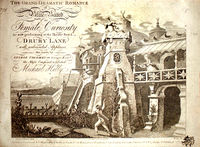Annotation:Blue Beard
X:1 T:Blue Beard M:2/4 L:1/8 R:Country Dance B:T. Skillern - Twenty-Four New Country Dances for the Year 1799 (p. 11) Z:AK/Fiddler's Companion K:A e/f/e/d/ c/d/c/B/|AA/c/ BB/d/|cc/e/ f/e/d/c/|c/B/B/B/ B2| e/f/e/d/ c/d/c/B/|AA/c/ BB/d/|c/B/c/d/ c/B/A/G/|AA A2:| |:B>AGA|BA/B/ cB/c/|d/c/d/e/ f/e/d/c/|c/B/B/B/ B2| B>AGA|B/A/B/c/ Bc|B/^d/f/a/ g/e/f/d/|eeez!D.C.!:|]
BLUE BEARD. AKA and see "March in Bluebeard." English, Country Dance Tune (2/4 time). A Major. Standard tuning (fiddle). AABB. Blue Beard; or Female Curiosity was a pantomime produced in 1798, with music by Michael Kelly and text by George Colman, the Younger. Advertised as a "Grand Dramatick Romance" it was written as an alternative for a Christmas pantomime, accessible to children in the audience. The Royal College of Music's Virtual Exhibition (Pantomime and the Orient) explains:

Scenic spectacles and rapid transitions, brought about by Harlequin’s magic wand were the stock-in-trade of pantomime, and they brought good box-office returns. Michael Kelly had seen Grétry’s opera Barbe Bleue, based on Perrault’s fairy tale, in Paris in 1790. He paid Colman to make a libretto out of it, and Colman turned the French villain into a Turkish one, Abomelique. Reviews of Blue Beard were very mixed, but the work was popular with audiences. £2000 was spent on its preparation. Its most impressive effect was a grand cavalcade across the mountains, which used model figures and animals growing larger at each successive appearance. [1]
The tune is a version of a march from the opera, better-known under the title "March in Bluebeard."

